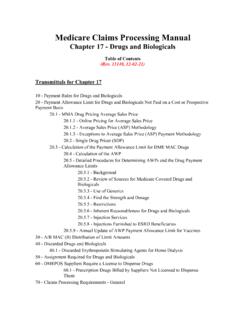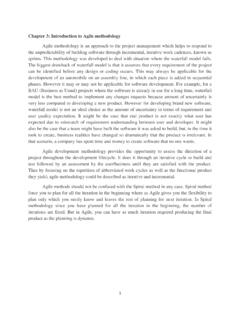Transcription of Chapter 4 : ERP Implementation Methodologies and Strategies
1 MD61 Createforecast401ME59 NConvert topurchase orderMIGOPost goodsreceipts405 MIROPost invoice406F-53 Post payment407CO41 Mass releaseproduction order410CO15 Con rmproduction411VL01 NCreate delivery413VF01 Create billing414 IndependentrequirementPurchaseorderGoods receiptProductionorderDeliveryCash Acc. CRDB CRAcc. Rec. RevenuesDB CRDB CRInventory Finished change productDB CRDB CRDB CRDB CRCons. Raw raw materialRaw mat GR/IRDB CRDB CR GR/IR Acc.
2 CRDB CRAcc. Pay. CashDB CRDB CRFinished outputDB CRDB CRDomesticsale revenuesRaw materialconsumptionInventory changesold productFactory outputproductionInvestmentsInvestments CashDB CRDB CRMD07 Releaseproduction order409305MD01 Execute MRPMD61 Createforecast401ME59 NConvert topurchase orderMIGOPost goodsreceipts405 MIROPost invoice406F-53 Post payment407CO41 Mass releaseproduction order410CO15 Con rmproduction411VL01 NCreate delivery413VF01 Create billing414
3 IndependentrequirementPurchaseorderGoods receiptProductionorderDeliveryCash Acc. CRDB CRAcc. Rec. RevenuesDB CRDB CRInventory Finished change productDB CRDB CRDB CRDB CRCons. Raw raw materialRaw mat GR/IRDB CRDB CR GR/IR Acc. CRDB CRAcc. Pay. CashDB CRDB CRFinished outputDB CRDB CRDomesticsale revenuesRaw materialconsumptionInventory changesold productFactory outputproductionInvestmentsInvestments CashDB CRDB CRMD07 Releaseproduction order409305MD01 Execute MRPC hapter 4 : ERP Implementation Methodologies and Strategies Mary M.
4 Dunaway (University of Arkansas)Introduction This Chapter provides an overview of the various ERP imple-mentation approaches, trends across industry, and their impact on organizations. Astoundingly, 65% of executives believe that ERP systems have at least a moderate chance of hurting their businesses due to the potential for Implementation problems (Dey, Clegg, & Bennett, 2010). This major concern and increas-ing number of ERP implementations has brought about greater appreciation and attention to the challenges involved in imple-menting these complex technologies.
5 ERP implementations are not just COTS (commercial off the shelf applications), but are radical changes to a company s business process, IT infrastruc-ture, and strategic and tactical goals. The ERP methodology and strategy becomes critical to a company adapting new technol-ogy and bears substantial influence to how the organization manages the adoption and change process of the ERP technol-ogy Basic Concepts and DefinitionsThere are several key definitions and concepts that are important to help understand ERP Implementation strategy and method-ology. The ERP Implementation strategy is how an organization goes about planning and directing the deployment of an ERP application.
6 Implementation Strategies address mapping the company s business processes to a system in an organized and defined manner. ERP Strategies are mainly driven by industry best practices and can be tailored to fit an organization s needs. ERP Implementation methodology is where the company declares their strategic decisions regarding how to conduct the imple-mentation, and selects a focused path for ERP driven Implementation strategy is when a company drives the leadership and direction for how the ERP system is implemented. Often, in order to support this type strat-egy a company has an established corporate Implementation methodology that dictates how to approach their software implementations.
7 A company s software development depart-ment generally has the expertise to accomplish this type effort. Vendor led Implementation Strategies are usually proprietary in nature and are a well-defined, structured approach to the ERP Implementation . ERP vendors have turnkey Implementation approaches based on best practices and lessons learned from each successive implementations performed. Usually, the ERP vendor has worked out most issues irrespective of the industry, and can provide a well-suited Implementation . The ERP vendor typically has templates, tools, procedures, and knowledge experts readily available to jump start an ERP Implementation encompasses the processes, activities, and tasks to implement an ERP system.
8 The elements, variables, and actions are controlled during the execution of an ERP system Implementation . An ERP deployment refers to the distribution of the ERP system to determined recipients. There is a distinc-tion between these two terms where Implementation is the building of the necessary structures to distribute, and deploy-ment encompasses ERP system distribution based on company business criteria. Once the ERP system has been deployed, the practical term Sunset specificies when the legacy system is no longer in use. ERP consultants and contractors are expert ERP knowledge workers hired for a specific project or service.
9 These individuals are usually trained professionals who chooses to perform important ERP functions for a client. The ERP contract-or operates under the auspices of a working agreement with the company, and is available for a specified period of time in exchange for the completion of specific tasks. An emerging innovation used for ERP implementations is cloud computing, which is a type of Internet-based technology whereby shared servers provide resources, software, and data to computers and other devices on ERP Implementation StrategyThe ERP Implementation strategy is a major decision for company executives and stakeholders to make.
10 The implemen-tation strategy describes the plan for change that ensures align-ment with overall corporate objectives and goals (Al-Mashari & Zairi, 2000). The strategy defines the organizational principles and approach to executing the ERP Implementation . Figure 1 shows key aspects to be addressed in order to sustain strategic focus for the ERP Implementation ERP Implementation Methodologies and StrategiesCHAPTER 4 Readings on Enterprise Resource PlanningPreliminary Version - send comments to topurchase orderMIGOPost goodsreceipts405 MIROPost invoice406F-53 Post payment407CO41 Mass releaseproduction order410CO15 Con rmproduction411VL01 NCreate delivery413VF01 Create billing414 IndependentrequirementPurchaseorderGoods receiptProductionorderDeliveryCash Acc.















